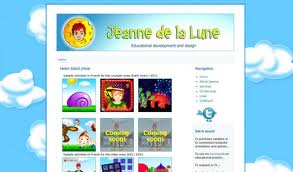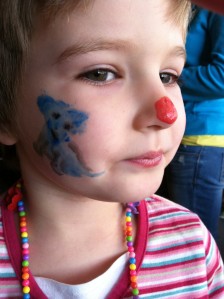I am committed to life-long learning and hope to continue learning and growing my entire life. I am so grateful to have found the langchat hash tag on twitter. The educators who share ideas and resources using #langchat have sparked me to critique and tweak my teaching techniques and have helped me bring new, exciting lessons to my students. From engaging, interactive videos to fun songs and dances, my professional learning network offers it all with free professional development topping the list. The feedback from students and parents alike has been phenomenal. Students are taking what we learn in class and sharing it around school and in their homes. Just today, a parent shared with me that she had a houseful of 7th grade girls singing songs in Spanish and French all night long during a sleepover.
Never before have I been able to connect with innovative teachers outside my district like I have since following #langchat. Just last month, I was invited by Sylvia Duckworth (@sylviaduckworth) to visit her classroom and to attend a two-day AIM Language workshop. Through twitter, Sylvia had also helped me connect with another French teacher, Mardi Michels (@eatlivtravwrite) at the NYSAFLT conference. Mardi gave a presentation “Haiti on a Plate,” which was the best presentation I attended. Mardi graciously invited me into her classroom as well.
I found out about the Accelerative Integrative Methodology (AIM) for language learning via the langchat hash tag. I came across a video of Stephen Lai’s (@sly111) AIM classroom learning the emotions in French. Stephen teaches elementary French in Richmond, British Columbia. When my two children saw the video, they couldn’t get enough and by the third viewing, they were acting out the emotions along with the student actor. The engagement and excitement of my four and two-year-old was what ignited my desire to learn more about the program. If it could keep their attention and encourage them to interact with French, then what could it do for my students’ language acquisition?
The four-day learning adventure started at Royal St. George’s College with Mardi and her 4th-6th grade classes. The next day I spent at Crescent School with Sylvia’s 3rd-6th grade classes. Lastly, I attended a two-day workshop where I had the opportunity to learn more formally about AIM from Sylvia, Renée Villeneuve (@ReneeVil) and Dan Bart. I will share here the two days spent in the classrooms. I will not attempt to share much from the two-day workshop. No amount of words could properly portray the learning. I highly recommend attending one, and hope to get back to Ontario in July for the summer institute! (You can visit here for offerings.)
After the observations, it was clear to me that when used properly, AIM was a very effective program that stood true to its claim to create astounding results. The fact that the teachers and students were conversing entirely in French was astounding, humbling and thrilling. The level of excitement and engagement of the students was exhilarating. I will now outline some of what I witnessed during the two days of observations.
-Class is conducted entirely in the target language (French, in this case, however, AIM offers programs in Spanish and English as well)
-Students are interacting with the language throughout the class time
-Students are engaged and excited about class
-Students not only passively understand the teacher, they also produce speech in the target language (and in complete sentences)
-Students were invited to ask me questions. Here are some of the questions they asked: Quel est ton nom? Est-ce que tu as des frères et sœurs? Combien de jours est-ce que tu restes ici? D’ou viens tu? Est-ce que tu as des animaux? Pourquoi tu es ici?
-Students created the following Phrases bizarres : Je fais du ski dans la maison. Je suis une banane/un ananas. Je suis un ananas qui joue au base-ball. Ananas danse et chante pendant le concert. Ananas joue au hockey avec les Maple Leaves. Une banane fait du patinage à la maison de Laurence. Une banane et une pomme jouent à la chasse avec Ananas! Un champignon mange 55 personnes sur une pizza. Ananas lance un œil et l’œil frappe Ananas sur la tête. Un hippopotame fait de la peinture dans le bayou.
-Gestures were used to help students understand the proper use of verb tenses. In one case, the imperfect tense was used to tell what they were for halloween: J’étais un squelette. J’étais un œuf. J’étais nourriture de chien. J’étais un jedi. J’étais un iPhone. J’étais un voleur. J’étais un iPad
-Students write in French independently: Students had written descriptions about themselves the day before. When asked what they did in class the day before, a student answered: « On a écrit des descriptions.» The desciptions were read aloud and the students had to guess who wrote it. The boys adored this activity and were extremely eager to be the person who guessed the correct classmate. Here is a couple examples of what the boys had written to describe themselves : 1. J’ai les cheveux blonds et raids. Je suis très grand. J’ai les yeux noisette. J’adore les sports de hockey et basket-ball. 2. Je suis de taille moyenne. J’ai les cheveux noirs. J’ai la peau olive. Je suis mince.
-The use of daily routines ensures language acquisition of key topics. Routines I saw include the outside-the-classroom rap to prepare students to enter the French-only space, hangman agenda (students play hangman to learn what they will be doing in class that day) and the following :
1. As students enter class, they are asked: Quel est la date aujourd’hui? Together, teacher and students state : Le jour, c’est vendredi. Le date, c’est le vingt-huit. Le mois, c’est octobre. L’année, c’est deux mille onze. La saison, c’est automne. Then they sing a little song : « Quel temps fait-il? » Then : Est-ce que le soleil brille ? Ou est-ce que le soleil ne brille pas ? Class continues to properly describe the weather as seen out the window. (« Oui » and « Non » were not acceptable answers. All responses were formulated into complete phrases)
2. Next was the time : « Quel heure est-il? » Il est neuf heures trente-huit
3. Another routine combined math with rewards : « Est-ce que tout le monde a les agendas? » OUI, madame! « Maintenant je peux donner les points aux groups » Groups must then add the numbers in French: Groups state their new number. Ex : « On a deux cent et dix points maintenant. » « On a cent quatre-vingt dix points maintenant. »
-Students paraphrased the plays they were learning for me so that’d I’d understand the plot of the play
-Students rewrote scenes of the play
-Students broke up into groups and practiced performing the plays
Wendy Maxwell, creator of the AIM program, made gestures to portray grammatical structures such as verb tenses, singular vs. plural and gender. The grammar of the language is ingrained in the gesturing and is taught within context. AIM takes the effectiveness of integrating gestures into language learning and ingeniously incorporates a multimodal, differentiated approach that draws all students into learning. Dan Bart stated that with AIM, even students with academic difficulties have access to learning and are successful where in other classes they may not be. I can definitely see how his statement would be true. I know spending two days in AIM classrooms does not make me an expert, however, the amount of student engagement and levels of teacher support I witnessed support Dan’s statement.
The gestures are only one of five key elements of the AIM program:
1. The Gesture Approach
2. Pared Down Language
3. Stories/Plays/Music/Dance
4. Language Manipulation Activities (written and oral)
5. Transfer to Spontaneous Speech and Creative Storytelling
Through the integration of all five key elements, Maxwell perfected her ingenious system which, when properly used, produces outstanding levels of fluency. When students speak and write in the target language, AIM teachers are trained to provide students with varying levels of support, flexible enough to meet the needs of all learners.
Last year I started integrating American Sign Language (ASL) into my teaching. I taught some of the basic phrases of greeting and expressions of courtesy (which I had remembered from first grade). I found that if the students forgot a phrase, all I had to do was provide them with the sign, and that would spark their memory and they would then be able to say the phrase. I planned to learn and incorporate more ASL into lessons but then, I joined twitter, found #langchat and subsequently discovered AIM Language (#aimlang), and as I’ve heard other AIM teachers say: I’ll never look back! To me, it seems as if Wendy Maxwell fashioned a program that recreates the natural way one acquires language as a young child. As we grow up, we learn through the repetition of hearing words and phrases as we, or as our parents, are performing the actions. In AIM, the stories, music and plays give the opportunity for children to learn the language while performing the language. AIM thus exemplifies the Ancient Chinese Proverb: Tell me and I will forget; teach me and I will remember; involve me and I will learn. AIM involves students in such a way that keeps the affective filter low and the engagement high. AIM also makes learning fun, and I think we all learn better when we feel good about what we’re learning.
I am so excited to have had this learning adventure…and the adventure has only just begun!
 To read a blog post I wrote about AIM, visit here. Special thanks to Zak for the photo! 🙂
To read a blog post I wrote about AIM, visit here. Special thanks to Zak for the photo! 🙂




